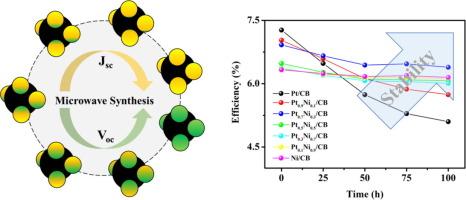Synergistic effects of Pt-Ni alloy-decorated carbon black nanofillers on performance and stability of quasi-solid-state dye-sensitized solar cells
IF 13.3
1区 工程技术
Q1 ENGINEERING, CHEMICAL
引用次数: 0
Abstract
Quasi-solid-state dye-sensitized solar cells (QSDSCs) feature better stability and facile packaging in contrast with typical dye-sensitized solar cells (DSCs) using volatile liquid electrolytes. However, the performance and stability of QSDSCs are strongly influenced by nanofillers, whose role in the composite polymer electrolyte remains insufficiently understood. In this regard, a series of Pt-Ni alloys on carbon blacks (CBs) were synthesized using a microwave-assisted method, enabling a systematic investigation of these materials as nanofillers in QSDSCs for the first time. The nanofillers of CBs decorated with highly catalytic Pt can function as the extended counter electrode, which can improve the short-circuit current density by reducing charge transfer resistance at the counter electrode/electrolyte interface and improving the electrolyte conductivity. Additionally, alloying Pt with Ni on CBs can increase recombination resistance at the interface between the dye-adsorbed TiO2 photoanode and electrolyte. This minimizes voltage losses by reducing the concentration of free I3- ions in the electrolyte, leading to an improvement in the open-circuit voltage. The Ni content in Pt-Ni alloys can further prevent Pt dissolution in the redox electrolyte through a competitive dissolution, enhancing long-term stability in iodine-based electrolytes. As a result, QSDSCs using optimized Pt-Ni/CB nanofillers simultaneously achieve the comparable conversion efficiency and improved stability. This synergistic enhancement suggests that the optimal nanofiller properties in QSDSCs can be achieved through controlling the decoration of varied alloys on CBs to meet critical performance and stability requirements.

Pt-Ni合金修饰碳黑纳米填料对准固态染料敏化太阳能电池性能和稳定性的协同效应
与使用挥发性液体电解质的典型染料敏化太阳能电池(dsc)相比,准固态染料敏化太阳能电池(QSDSCs)具有更好的稳定性和易于包装的特点。然而,QSDSCs的性能和稳定性受到纳米填料的强烈影响,纳米填料在复合聚合物电解质中的作用尚不清楚。在此基础上,利用微波辅助方法合成了一系列碳黑(CBs)上的Pt-Ni合金,首次对这些材料作为纳米填料在QSDSCs中的应用进行了系统的研究。采用高催化Pt修饰的CBs纳米填料可以作为扩展的对电极,通过降低对电极/电解质界面处的电荷转移电阻和提高电解质的导电性来提高短路电流密度。此外,在CBs上合金化Pt和Ni可以增加染料吸附的TiO2光阳极和电解质之间界面的复合电阻。通过降低电解液中游离I3离子的浓度,使电压损失最小化,从而改善开路电压。Pt-Ni合金中的Ni含量可以通过竞争性溶解进一步阻止Pt在氧化还原电解质中的溶解,提高其在碘基电解质中的长期稳定性。因此,使用优化的Pt-Ni/CB纳米填料的QSDSCs同时实现了相当的转换效率和提高的稳定性。这种协同增强表明,通过控制不同合金在CBs上的装饰,可以实现QSDSCs中最佳的纳米填料性能,以满足关键的性能和稳定性要求。
本文章由计算机程序翻译,如有差异,请以英文原文为准。
求助全文
约1分钟内获得全文
求助全文
来源期刊

Chemical Engineering Journal
工程技术-工程:化工
CiteScore
21.70
自引率
9.30%
发文量
6781
审稿时长
2.4 months
期刊介绍:
The Chemical Engineering Journal is an international research journal that invites contributions of original and novel fundamental research. It aims to provide an international platform for presenting original fundamental research, interpretative reviews, and discussions on new developments in chemical engineering. The journal welcomes papers that describe novel theory and its practical application, as well as those that demonstrate the transfer of techniques from other disciplines. It also welcomes reports on carefully conducted experimental work that is soundly interpreted. The main focus of the journal is on original and rigorous research results that have broad significance. The Catalysis section within the Chemical Engineering Journal focuses specifically on Experimental and Theoretical studies in the fields of heterogeneous catalysis, molecular catalysis, and biocatalysis. These studies have industrial impact on various sectors such as chemicals, energy, materials, foods, healthcare, and environmental protection.
 求助内容:
求助内容: 应助结果提醒方式:
应助结果提醒方式:


